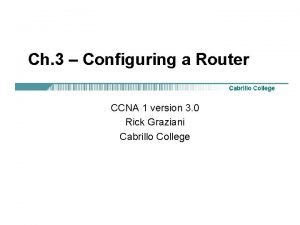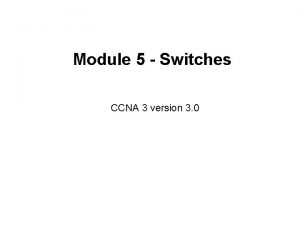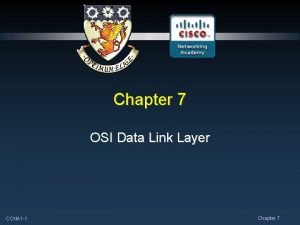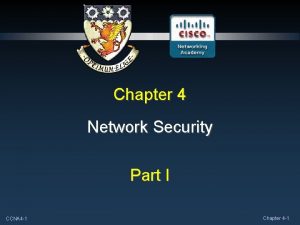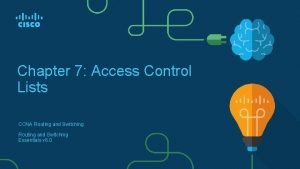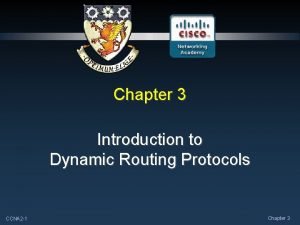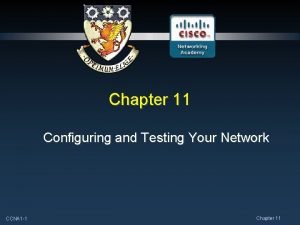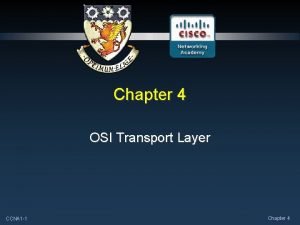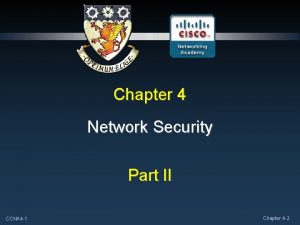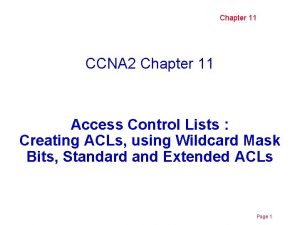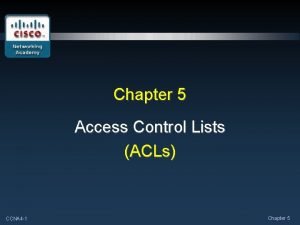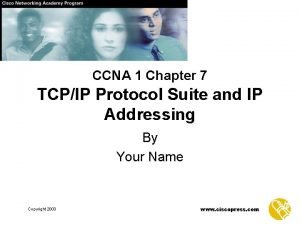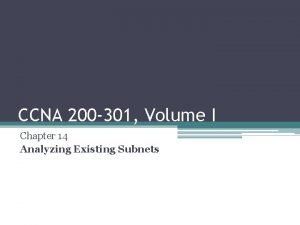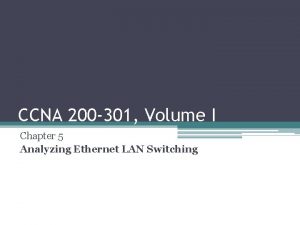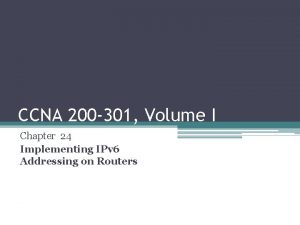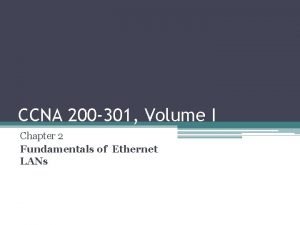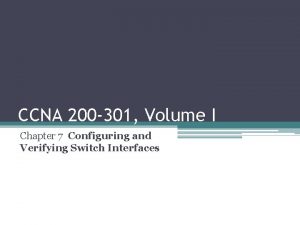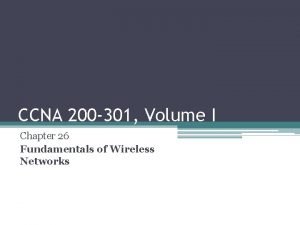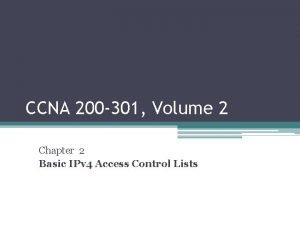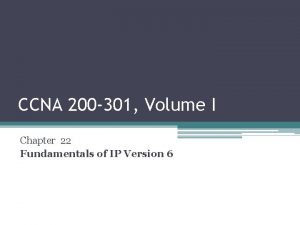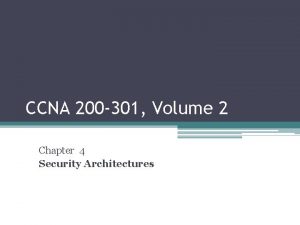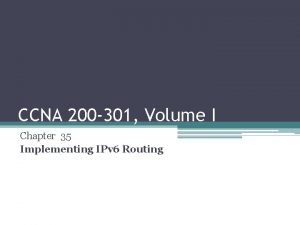CCNA 200 301 Volume I Chapter 27 Analyzing

















- Slides: 17

CCNA 200 -301, Volume I Chapter 27 Analyzing Cisco Wireless Architectures

Objectives • • Autonomous AP Architectures Cloud-based AP Architecture Split-MAC Architectures Comparing Wireless LAN Controller Deployments • Comparing Wireless LAN Controller Deployments

Wireless Network Architecture with Autonomous APs

Extent of a Data VLAN in a Network of Autonomous APs

Cisco Meraki Cloud-Based Wireless Network Architecture Notice that this network example consist of two distinct paths – one for data and one for management, corresponding to the following two functions: • A control plane: Traffic used to control, configure, manage, and monitor the AP itself. • A data plane: End-user traffic passing through the AP.

Autonomous Versus Lightweight Access Point

Linking a Lightweight AP and WLC with CAPWAP

Extent of VLAN 100 in a Cisco Wireless Network

Using CAPWAP Tunnels to Connect APs to One Central WLC

WLC Functions • Dynamic channel assignment: The WLC can automatically choose and configure the RF channel used by each AP, based on other active access points in the area. • Transmit power optimization: The WLC can automatically set the transmit power of each AP based on the coverage area needed. • Self-healing wireless coverage: If an AP radio dies, the coverage hole can be “healed” by turning up the transmit power of surrounding APs automatically. • Flexible client roaming: Clients can roam between APs with very fast roaming times. • Dynamic client load balancing: If two or more APs are positioned to cover the same geographic area, the WLC can associate clients with the least used AP. This distributes the client load across the APs. • RF monitoring: The WLC manages each AP so that it scans channels to monitor the RF usage. By listening to a channel, the WLC can remotely gather information about RF interference, noise, signals from neighboring APs, and signals from rogue APs or ad hoc clients. • Security management: The WLC can authenticate clients from a central service and can require wireless clients to obtain an IP address from a trusted DHCP server before allowing them to associate and access the WLAN. • Wireless intrusion protection system: Leveraging its central location, the WLC can monitor client data to detect and prevent malicious activity.

WLC Location in a Unified Deployment

WLC Location in a Cloud-based Deployment

WLC Location in an Embedded Deployment

WLC Location in a Mobility Express Deployment

Summary of WLC Deployment Models

Cisco AP Modes • Local: The default lightweight mode that offers one or more functioning BSSs on a specific channel. During times that it is not transmitting, the AP will scan the other channels to measure the level of noise, measure interference, discover rogue devices, and match against intrusion detection system (IDS) events. • Monitor: The AP does not transmit at all, but its receiver is enabled to act as a dedicated sensor. The AP checks for IDS events, detects rogue access points, and determines the position of stations through locationbased services. • Flex. Connect: An AP at a remote site can locally switch traffic between an SSID and a VLAN if its CAPWAP tunnel to the WLC is down and if it is configured to do so. • Sniffer: An AP dedicates its radios to receiving 802. 11 traffic from other sources, much like a sniffer or packet capture device. The captured traffic is then forwarded to a PC running network analyzer software such as Wildpackets Omni. Peek or Wire. Shark, where it can be analyzed further.

Cisco AP Modes (Continued) • Rogue detector: An AP dedicates itself to detecting rogue devices by correlating MAC addresses heard on the wired network with those heard over the air. Rogue devices are those that appear on both networks. • Bridge: An AP becomes a dedicated bridge (point-to-point or point-to-multipoint) between two networks. Two APs in bridge mode can be used to link two locations separated by a distance. Multiple APs in bridge mode can form an indoor or outdoor mesh network. • Flex+Bridge: Flex. Connect operation is enabled on a mesh AP. • SE-Connect: The AP dedicates its radios to spectrum analysis on all wireless channels. You can remotely connect a PC running software such as Meta. Geek Chanalyzer or Cisco Spectrum Expert to the AP to collect and analyze the spectrum analysis data to discover sources of interference.
 Ccna 200-301 slides
Ccna 200-301 slides Ccna 200-301 ppt slides download
Ccna 200-301 ppt slides download 100 200 300
100 200 300 Ccna 3 chapter 1
Ccna 3 chapter 1 What is a function of the data link layer ccna
What is a function of the data link layer ccna Ccna 4 chapter 4
Ccna 4 chapter 4 Ccna security chapter 1
Ccna security chapter 1 Ccna 4 chapter 1
Ccna 4 chapter 1 Ccna chapter 7
Ccna chapter 7 Ccna 2 chapter 3
Ccna 2 chapter 3 Ccna chapter 11
Ccna chapter 11 Expectational acknowledgement
Expectational acknowledgement Ccna 4 chapter 4
Ccna 4 chapter 4 Ccna 2 chapter 11
Ccna 2 chapter 11 Ccna 4 chapter 5
Ccna 4 chapter 5 Ccna 1 chapter 7
Ccna 1 chapter 7 200+200+100+100
200+200+100+100 200+400+600+800
200+400+600+800

